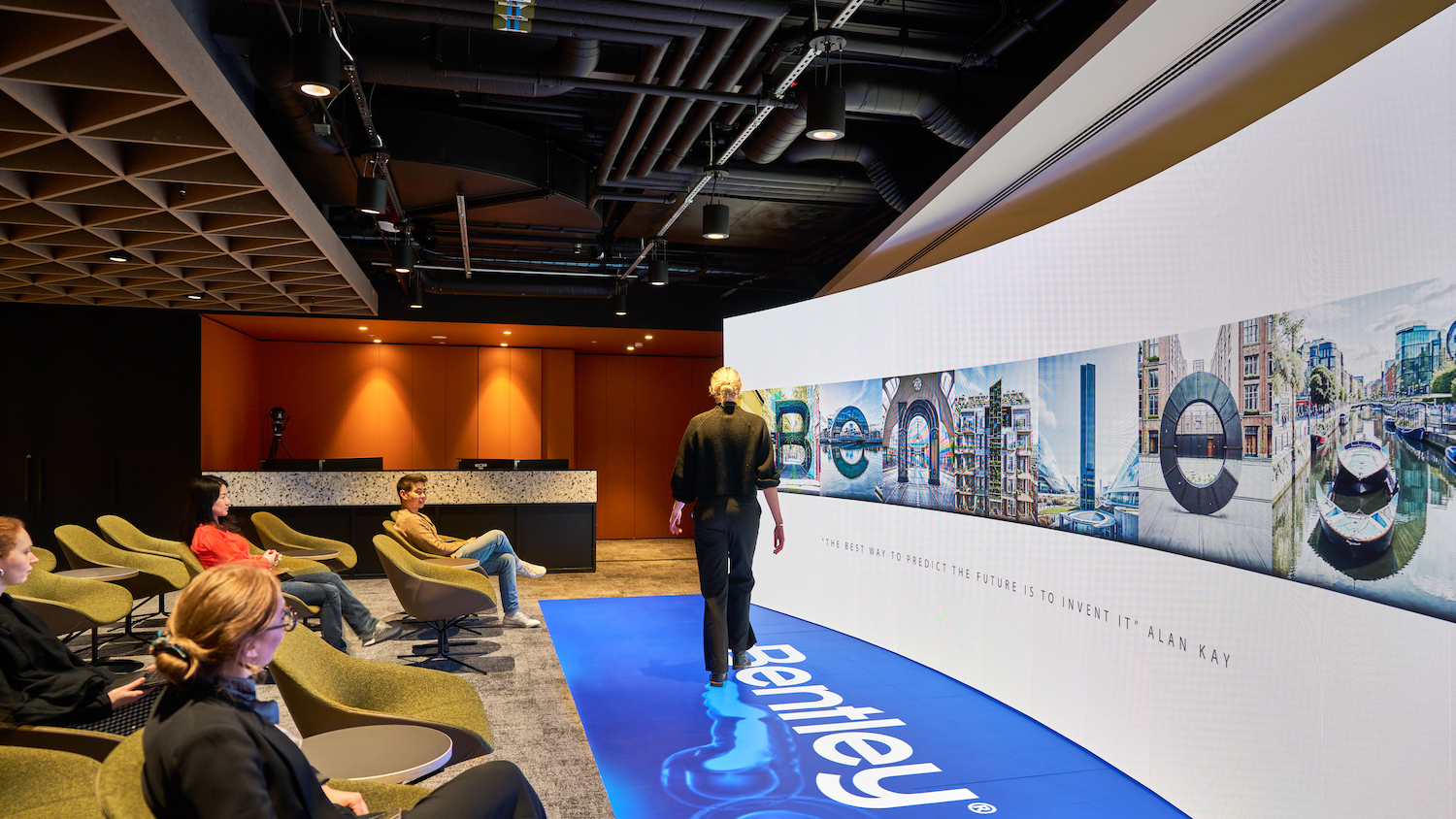
Infrastructure engineering software company Bentley Systems has unveiled a new platform for an unlimited scope digital twin of London as the centrepiece of its new ‘experience centre’ and headquarters in the city.
The London digital twin platform was displayed on a giant interactive screen in Bentley’s new centre on the 43rd floor of 8 Bishopsgate – a landmark 51-storey tower designed by Wilkinson Eyre and Arup that opened last year.
The opening of the new centre marks the company’s 40th anniversary. It was also announced that Greg Bentley will transition from the CEO to an executive chair role, with COO Nicholas Cumins promoted to CEO. Cumins has served as Bentley Systems’ COO since 2022.
Greg Demchak is senior director of the Digital Innovation Lab at Bentley Systems. His team leveraged a combination of Bentley’s iTwin, Google, Cesium and Unreal Engine to create the digital twin experience. He hopes it would be built up over time with data from BIM models of new projects being built in the capital: “We wanted to create it as a great interactive way of understanding London – its past, present and future.”
The geospatial model can be operated from an iPad, allowing users to navigate their way around the capital and zoom in on specific buildings. It combines Bentley’s iTwin software, photo-realistic 3D map tiles from Google Earth (which are a formulated from satellite images and photogrammetry) and Epic Games’ Unreal Engine. Demchak said the model was unique in having so many API connections allowing it to be linked to many different channels, including BIM models, IoT and point cloud scanning.
Because it is hyper-connected, information is not handed over to the Bentley digital twin, instead being streamed, so that data remains with those that own it. Demchak said that they were hoping to work with architects, developers and public bodies to get permission to stream their data, add new layers and map the changing face of London. He said that the new information would be made available to others to foster networking, create discussion around the future of infrastructure delivery and show how new buildings fit into their surroundings.
Bentley has already worked with public authorities to develop a digital twin of Singapore.
Analysing impact
At the opening of the new centre, Demchak was able to zoom into projects that Bentley had been involved with including 22 Bishopsgate, the Elizabeth Line and the Thames Tideway Tunnel, a new London sewer. He also used it to analyse the impact of sea level rises on London due to global warming temperature increases: “If we get to 4°C global warming, almost all this northern part of the city will be under water at that point.”
Demchak added: “The idea here is that we can continue to grow and add content. So as the city itself evolves, we can keep adding new information, new content, we can look back into the past, understand from where we came, where we are today and project the future and help understand where this great city is going next.”

Opportunities and challenges
During the event, Bentley Systems was joined by representatives from developer Lendlease, which built 8 Bishopsgate, which has achieved a BREEAM Outstanding designation and an EPC A rating. Bentley System’s structural engineering software and Synchro construction management tool were used on the project.
Ben Bateman, project director at Lendlease, said: “The project presented us with both opportunities and challenges, many of which Synchro was at the heart of resolving. It was truly due to Synchro that we were able to deliver it with the success that we have and enable you to be in here today.”
Bateman said that there had been a huge focus on reducing the carbon footprint of the building through optimisation of the steel frame and foundations. The building had only required 26 piles driven 70m into the ground – rather than a traditional pallet raft that might have required 180 piles – saving 500t of embodied carbon.
“As you walk through the building, you will notice that the steels are not necessarily common sizes right away across the floorplate, because the design decision was made to deliver an efficient carbon building, rather than match every beam to each other.”
He added: “So how do you deliver a building like this? You set out with an approach that suggests that you have to ‘build it’ before you build it. We knew that when we set out on this journey we needed to ensure that we tested and validated our approaches, which is where Synchro came in.”
Detailed pre-planning
Bateman added that any issues experienced on a high-rise construction project cascade through the job and create unequivocal delays that have knock-on effects across every element. “As a result, we needed to ensure that we pre-planned every activity down to the finest level of detail,” he said.
This was also paramount to keep the public safe, as well as site workers. “We over-sailed the public highway by 6m on our western border. At 206m above the public, we could not afford for anything to go wrong. So, we engaged Synchro to bring our entire supply chain on the journey to the point where we knew where people would stand before a bit of steel was installed and how we would tether a facade panel to ensure that no one was put at risk.
“And as a result, not one member of the public was injured as part of the project. And no incidents occured where Synchro was used to pre-plan the works.”
Bateman said that as the project had got underway when Covid-19 struck, Synchro provided the ability to pre-plan digitally and remotely and kept the project going.
Bentley Systems CEO Greg Bentley said: “It is only fitting to begin our 40th anniversary celebrations in the UK, where we are also marking 30 years in business. Our new London home, 8 Bishopsgate, represents the best of British infrastructure and demonstrates the increasing importance of both going digital and prioritising sustainability to improve infrastructure delivery and performance.”
Don’t miss out on BIM and digital construction news: sign up to receive the BIMplus newsletter.














